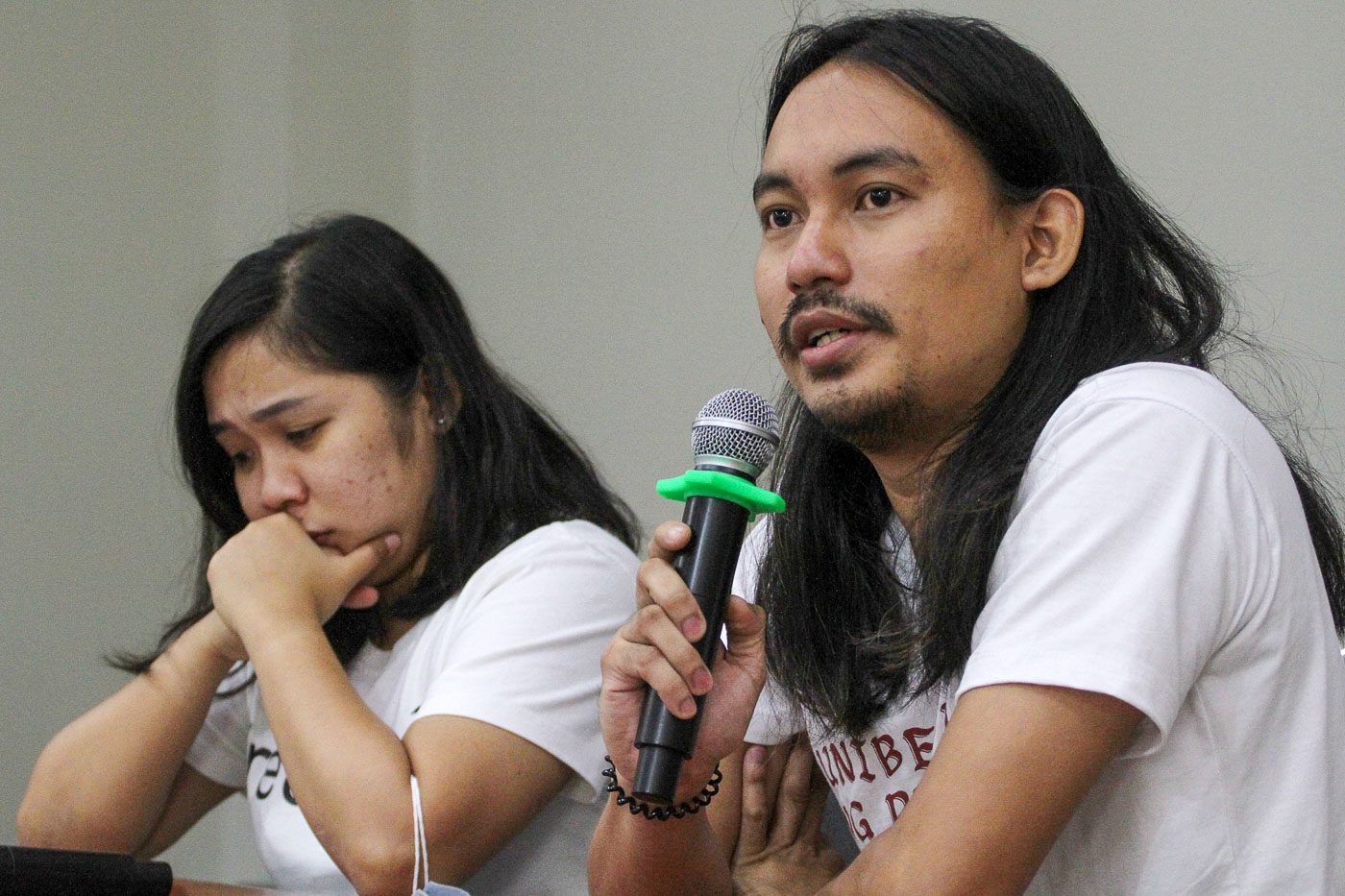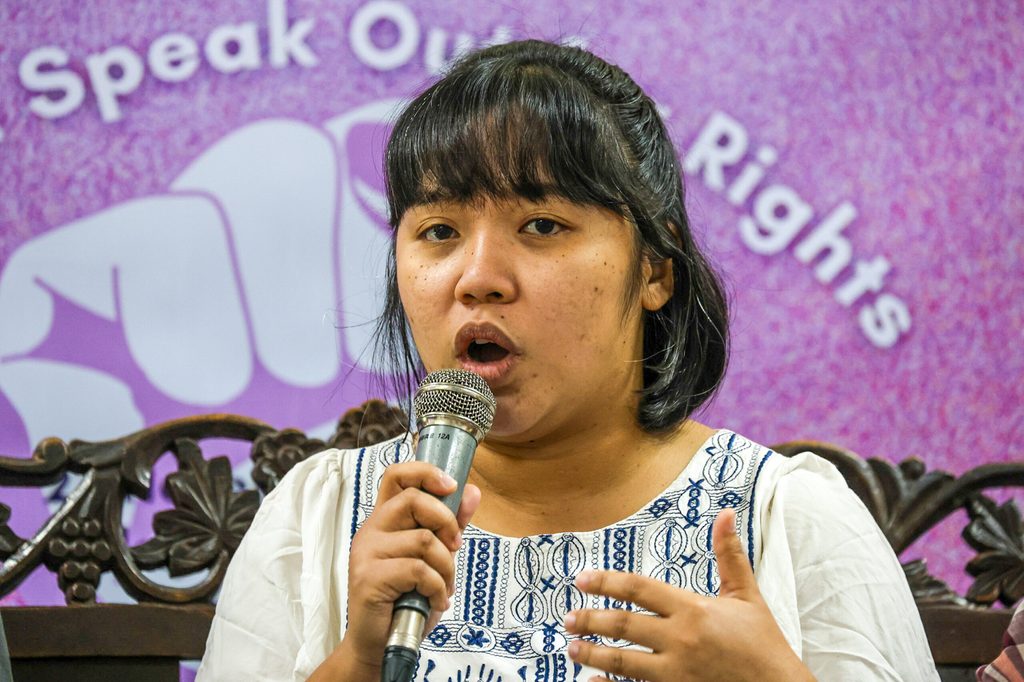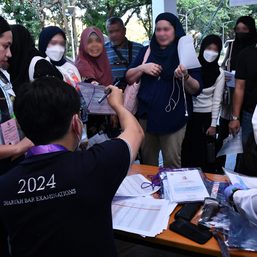SUMMARY
This is AI generated summarization, which may have errors. For context, always refer to the full article.

First of 2 parts
MANILA, Philippines – It’s not easy to say it was just luck, said Dyan Gumanao, that she and partner Armand Dayoha were released by their captors alive, dropped off at a resort in northern Cebu on January 15, 2023, with no other hard demand but to post a nonchalant MyDay on their Facebook.
Dyan’s narration of their ordeal from their abduction at the Cebu City port on January 10, 2023 tells a story of a couple with extraordinary connection – blindfolded and hands zip-tied, and separated for most of the days, they passed messages to each other by writing with fingers on the other’s palm whenever they were transported in a car, and by using food as codes whenever they were allowed to share meals.
Armand, Dyan said, was resolute from the beginning that they were not going to give in to their captors’ wishes, which was to sign an affidavit that they were surrendering as communist rebels, and potentially to be presented to the public as “returnees.” They were going to play a long game, and Armand communicated that by using their meals: appetizer comes first, dessert last, they would say, or code for “do not give in to what they want at the first instance, save it for last.”
Maybe it was that: that they were two strategic thinkers. Or maybe that their fellow activists mounted an effective surface campaign that put the pressure on their captors. Maybe they picked the wrong victims. Or maybe, 29-year-old Dyan said, it’s that their captors were lousy. “Sabi nga nila, walang perfect crime din, parang ang dami din kasi nilang, tingin namin ang daming loopholes (As they say, there is no perfect crime, because for us, they had a lot of loopholes)” Dyan told Rappler in an interview done in Quezon City on November 28, 2023.
An imperfect crime, the wrong victims, and a closed-circuit television (CCTV) are what may crack these cases open as the Commission on Human Rights (CHR) reaches a rare stage. Rappler has exclusively learned that the CHR found solid links: a name of a person and a motorcycle that are involved in Dyan and Armand’s abductions can be traced to the Intelligence Service of the Armed Forces of the Philippines (ISAFP).
To Alfred Balajola, the CHR investigator, this is the closest they have ever come to identifying a state perpetrator.
“Kaya nga natagalan siya kasi di mo puwedeng i-close nang ganito eh. Sayang naman yung effort na mukhang may lead ka talaga (This is why it’s taken us long, because we cannot close it like this. We don’t want to waste our efforts if you have a solid lead),” Balajola told Rappler in an interview on December 7, 2023.
Rappler reached out to Armed Forces of the Philippines (AFP) Spokesperson Colonel Medel Aguilar on December 4, 2023, to ask for their side of the story. An interview was set with him for December 13 but they canceled the night before, citing a conflict in schedule. A list of questions was emailed on December 14, which the AFP’s Public Affairs Office (PAO) had confirmed receiving. We followed up with PAO on January 1, 2024 and Aguilar on January 3, but neither has responded as of writing. We will update this story once they do.

The new pattern
Activists have called out this emerging pattern of “fake surrender,” where they are held captive until they execute an affidavit denouncing their leftist affiliations, and do whatever the demands are: be an asset or just stay quiet.
In the case of Dyan and Armand, their captors were very sympathetic to their causes, saying it’s “part of democracy.” All they asked of them, Dyan said, was to “keep in touch and coordinate.”
Since 2018, human rights group Karapatan has documented 14 instances of “fake surrenders.”
“Anecdotally, in these cases, state forces have deliberately made sure that there are formalities or trappings of legitimacy or legality. The conditions are hostile which the Desap (Anti-Enforced Disappearance) Law would have addressed. But until and unless we show the public and the victims that you can rely on the judicial process to seek relief, then it’s going to be very difficult,” said Edre Olalia, chairperson of the National Union of Peoples’ Lawyers (NUPL).
The CHR investigation
Perhaps Dyan was right – that her and Armand’s captors were a little lousy, even negligent. For one, they abducted the two in broad daylight at a crowded port. Soon enough, a video was released, seemingly filmed by a bystander from an elevated position. In the video, masked men were seen shoving Dyan and Armand into a gray Innova with onlookers just nearby. “Help them!” someone was heard shouting in the video.

Port authorities told CHR investigators that someone who identified himself as being with the armed forces coordinated beforehand that they were going to apprehend people wanted for estafa. The person was referred to the port authorities by maritime police, said Balajola, giving the coordination request credibility.
Text messages to the port authority revealed several names, later confirmed in a manifesto of passengers at the Escalante Port where Dyan and Armand were taken before their final destination in Carmen. The final name was then traced to ISAFP.
In the initial correspondences with the AFP, there was a misspelling in the name that forced the CHR to redo the summons. The first response they got was that this person had gone AWOL (absence without leave), said Balajola. Another response from the AFP on December 18, 2023, said the person would not be able to attend a hearing because he was in Marawi.
CCTV from the Cebu port showed a motorcycle tailing the gray Innova, which the CHR again traced to ISAFP.
“Kung totoo naman na hindi sa kanila, ginamit ‘yung plate number nila (If it’s true that the motorcycle is not theirs, then somebody used their plate number,” said Balajola.
They were able to arrange an ocular inspection to see the motorcycle in the ISAFP compound, but “‘nung pagpunta namin, although may usapan na kami, hindi na kami makapasok (when we went there, although we had a prior arrangement, we could no longer enter),” said Balajola. That’s when CHR started sending summons.
When Rappler talked to Aguilar via text on December 8, the AFP spokesperson said he was “not aware of the CHR notice.”
The CHR started sending summons to the AFP in July 2023. The back-and-forth lasted until November 2023 when the person of interest sent a counter affidavit denying any involvement. The CHR insisted on having a clarificatory hearing and on December 18, 2023, the Judge Advocate General Service (JAGS) – the military’s main legal unit – sent a response asking for the clarificatory questions.
That is the latest status of the investigation, after which the CHR can choose its next step: issue a final report and recommendation, file a complaint if they find enough basis to do so, or close the probe, depending on the outcome of the next phase. This is why Rappler is withholding the name of the ISAFP agent, pending further investigation.
Endemic disappearances
Before this, the last case that identified a state agent involved in an abduction of an activist was that of Jonas Burgos, who disappeared on April 28, 2007. The smoking gun was also a vehicle, with a plate number linked to the army’s 56th Infantry Battalion in Bulacan. Burgos is still missing, and the only state agent ever charged in court was an army major who was acquitted in 2017.
From 1986 to present, there have been 1,911 cases of enforced disappearances in the Philippines, according to Karapatan, including Jonas.
The 14 cases of “fake surrenders” since 2018 involve a total of 147 victims. All of them are alive and accounted for, allowing for documentation.
That the victims are alive also means they continue to live under threat, with most of them choosing to go low-profile. It is also possible that some cases went undocumented because they adhered to the demands of their captors.
Or that they are dead. (To be concluded) – Rappler.com
NEXT: Part 2 | Play the psy-war game: Young activists try to crack the case of disappearances
2 comments
How does this make you feel?


















![[Just Saying] A reawakened Supreme Court?](https://www.rappler.com/tachyon/2024/05/reawakened-supreme-court-may-21-2024.jpg?resize=257%2C257&crop=384px%2C0px%2C1080px%2C1080px)




An appreciation to the Commission on Human Rights for a work well done. Keep it up.
Enforced disappearances and fake surrenders are standard actions of the military with “utak pulbura (gunpowder-filled brain).” Unfortunately, in fairness to the Military Establishment, it is under a Civilian who is their Commander-in-Chief. With a strict obey first before you complain attitude and behavior, the Military merely reflects its Commander-in-Chief.